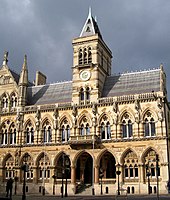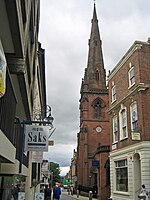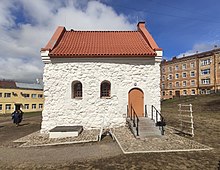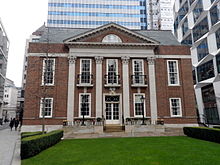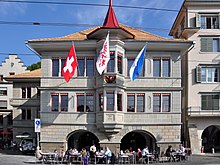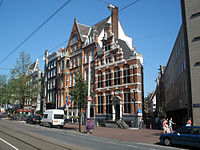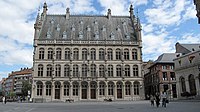
A guild is an association of artisans and merchants who oversee the practice of their craft/trade in a particular territory. The earliest types of guild formed as organizations of tradespeople belonging to a professional association. They sometimes depended on grants of letters patent from a monarch or other ruler to enforce the flow of trade to their self-employed members, and to retain ownership of tools and the supply of materials, but most were regulated by the local government. Guild members found guilty of cheating the public would be fined or banned from the guild. A lasting legacy of traditional guilds are the guildhalls constructed and used as guild meeting-places.
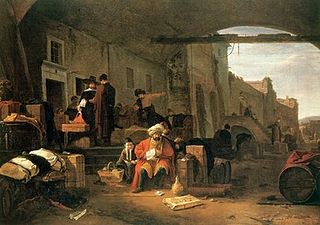
A merchant is a person who trades in commodities produced by other people, especially one who trades with foreign countries. Historically, a merchant is anyone who is involved in business or trade. Merchants have operated for as long as industry, commerce, and trade have existed. In 16th-century Europe, two different terms for merchants emerged: meerseniers referred to local traders and koopman referred to merchants who operated on a global stage, importing and exporting goods over vast distances and offering added-value services such as credit and finance.

Haarlem is a city and municipality in the Netherlands. It is the capital of the province of North Holland. Haarlem is situated at the northern edge of the Randstad, one of the more populated metropolitan areas in Europe; it is also part of the Amsterdam metropolitan area. Haarlem had a population of 162,543 in 2021.

The Grand-Place or Grote Markt is the central square of Brussels, Belgium. It is surrounded by opulent Baroque guildhalls of the former Guilds of Brussels and two larger edifices; the city's Flamboyant Town Hall, and the neo-Gothic King's House or Bread House building, containing the Brussels City Museum. The square measures 68 by 110 metres and is entirely paved.

A market town is a settlement most common in Europe that obtained by custom or royal charter, in the Middle Ages, a market right, which allowed it to host a regular market; this distinguished it from a village or city. In Britain, small rural towns with a hinterland of villages are still commonly called market towns, as sometimes reflected in their names.
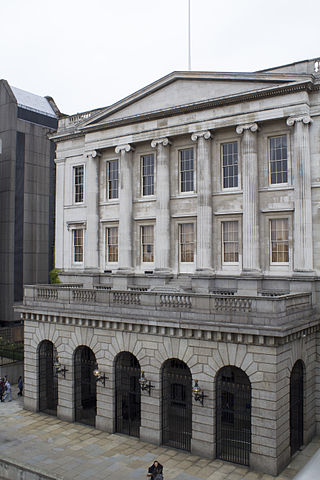
A livery company is a type of guild or professional association that originated in medieval times in London, England. Livery companies comprise London's ancient and modern trade associations and guilds, almost all of which are styled the "Worshipful Company of" their respective craft, trade or profession. There are 111 livery companies in total. They play a significant part in the life of the City, not least by providing charitable-giving and networking opportunities. Liverymen retain voting rights for the senior civic offices, such as the Lord Mayor, Sheriffs and Common Council of the City Corporation, London's ancient municipal authority with extensive local government powers.
The Steelyard, from the Middle Low German Stâlhof, was the kontor of the Hanseatic League in London, and their main trading base in England, from the 13th and 16th centuries. The main goods that the League exported from London were wool and from the 14th century woollen cloths. An important import good was beeswax. The kontor tended to be dominated by Rhenish and Westphalian traders, especially from Cologne.

The Merchant Taylors' Hall in York, England, is a medieval guildhall near the city wall in the Aldwark area of the city.

The Town Hall of Leuven, Flemish Brabant, Belgium, is a landmark building on that city's Grote Markt, across from the monumental St. Peter's Church. Built in a Brabantine late-Gothic style between 1439 and 1469, it is famous for its ornate architecture, crafted in lace-like detail.
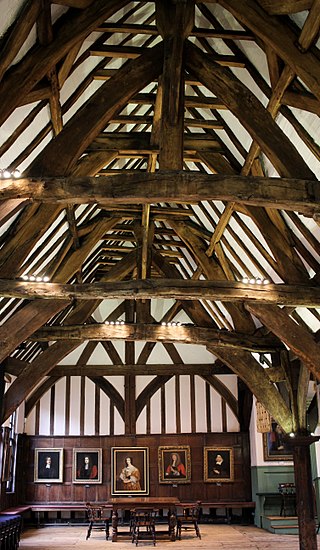
The Merchant Adventurers' Hall is a medieval guildhall in the city of York, England. It is a Grade I listed building and scheduled ancient monument.

The Grote Markt is the central square of Leuven, Flemish Brabant, Belgium. It is situated between the Oude Markt and the Rector De Somerplein and near both the Bondgenotenlaan and the Muntstraat.

Cambridge Guildhall is a civic building in the centre of the historic city of Cambridge, England. It includes two halls, The Large Hall and The Small Hall, and is used for many disparate events such as comedy acts, conferences, craft fairs, live music, talks, and weddings. It is also used by the University of Cambridge for certain examinations. It is owned and managed by the Cambridge City Council, and it is their seat of government. The Guildhall is located on the south side of Market Hill, the market square in Cambridge, between Peas Hill to the west and Guildhall Street to the east. It is a Grade II listed building.
A cloth hall or linen hall is a historic building located in the centre of the main marketplace of a European town. Cloth halls were built from medieval times into the 18th century.
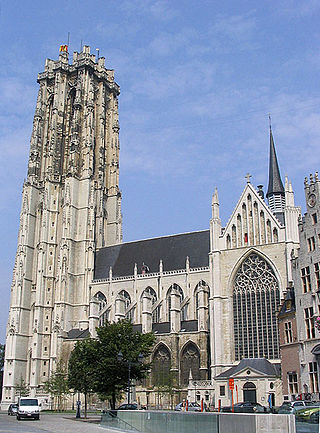
Brabantine Gothic, occasionally called Brabantian Gothic, is a significant variant of Gothic architecture that is typical for the Low Countries. It surfaced in the first half of the 14th century at St. Rumbold's Cathedral in the city of Mechelen.
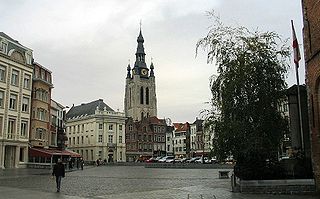
The Grote Markt is the central square of Kortrijk, West Flanders, Belgium. Its location on the crossing of some of Kortrijk's most famous and most touristic spots makes the Grote Markt one of the city's busiest squares. It has been pedestrian-friendly since its redevelopment in 1999–2000 and the largest part of the square is now a pedestrian area.

The Grote Houtstraat is a shopping street in Haarlem that connects the Grote Markt to the Houtplein in the direction of the Haarlemmerhout woods.

The Grote Markt is the central square of Antwerp, Belgium, situated in the heart of the old city quarter. It is surrounded by the city's Renaissance Town Hall, as well as numerous guildhalls with elaborate façades, the majority of which are reconstructions from the 19th and early 20th century, approximating paintings of the square by Flemish artists. A few of the guildhall façades, such as that of Sint-Joris's are intact originals entirely dating back to the 16th century.

The Guilds of Brussels, grouped in the Nine Nations of Brussels, were associations of craft guilds that dominated the economic life of Brussels, Belgium, in the late medieval and early modern periods. From 1421 onwards, they were represented in the city government alongside the patrician lineages of the Seven Noble Houses of Brussels, later also in the States of Brabant as members of the Third Estate. As of 1421, they were also able to become members of the Drapery Court of Brussels. Together with the Seven Noble Houses, they formed the bourgeoisie of the city. Some of their guildhouses can still be seen as part of the UNESCO World Heritage Site of the Grand-Place/Grote Markt in Brussels.
The following is a timeline of the history of the municipality of Bruges, Belgium.

University Hall in Leuven, Belgium is a medieval cloth hall with 17th and 18th-century extensions that is now the main administrative building of the KU Leuven. Heavily damaged during the Sack of Leuven in August 1914, the building was restored 1921–1926. It has been a listed building since 26 November 1942, and protected built heritage since 14 September 2009.



